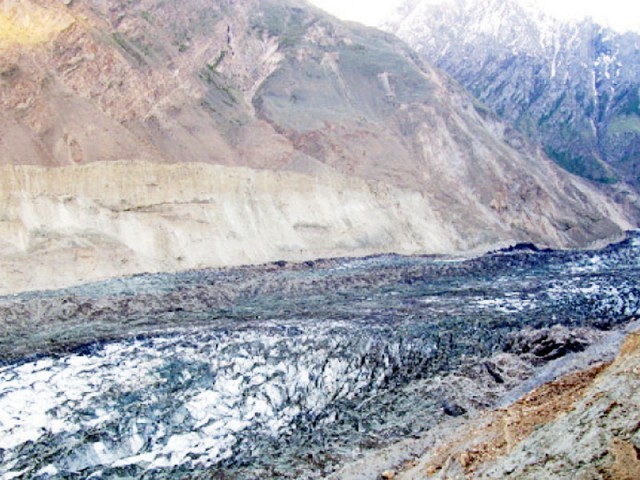HunzaNews, August 16th, 2014.
Standing on a cliff, he pointed down at the Hopar Glacier, more than a thousand metres below, its surface covered by massive boulders it had swept out of its way as it carved a valley through the Karakoram Mountains.
In the distance rises Mt Spantik, the snow-covered, 7,027 metre-high confluence of five major glaciers, including two of the largest five bodies of ice outside the Polar Regions. One of the tallest peaks of the Karakoram Mountains, Spantik is part of the Upper Indus Basin, the source for most of the rivers in South Asia, making it a vitally important environmental resource for the lives of people across the region.
Down below, lines of vegetation cut across otherwise barren valley walls. Trees and shrubs grow along artificial irrigation canals – some of them centuries old – built by locals to carry water from lakes formed by melting glaciers to their homes. If the glaciers melt too rapidly, those villages are at risk of flooding.
“Not just here, but all over Gilgit-Baltistan [region], most [glaciers] are downsizing, retreating in their positions,” said Ali, a researcher at the Karakoram International University. “It could be due to carbon emissions, or shifting monsoon precipitation, or to a natural cycle, maybe an inter-glacial age, or some combination – but it needs to be studied.”
Until recently it has not been. Despite the environmental importance of the area, there are only a handful of climate monitoring stations installed in the Karakoram Mountains. In the absence of field measurements, Ali and other local scientists say international researchers are using unreliable data, often not shared with others, to reach conclusions that do not reflect what is being observed on the ground.
“I can tell you my observations, but without data, how can I make a model, how can I make a forecast?” asked Ali. “I need parameters – temperature, humidity, precipitation, wind, pressure. Until you have a [historical] record [of these], you cannot say anything.”
Now new initiatives are aiming to collect and share more climate change data, which could enable scientists and policymakers to make better decisions on where to build dams, potentially protecting millions downstream from devastating floods.
Gathering and sharing data
In April, a team of 45 Pakistani and international climate experts took part in a rare field visit to the region to get a first-hand look at the problem. The researchers spent nine days trekking to remote glaciers and meeting communities in the Karakoram Mountains.
“Before, everybody was operating on their own, there was no networking, no data sharing,” said Abdul Wahid Jasra, the country representative for the Kathmandu-based International Centre for Integrated Mountain Development (ICIMOD), which organised the visit.
ICIMOD is working to connect three major sources of data in the region – the Pakistan Meteorological Department (PMD), which collects weather data; the Pakistan Water and Power Development Authority (WAPDA), which monitors water levels in rivers and streams; and the Pakistan Space and Upper Atmosphere Research Commission (SUPARCO), which handles satellite data. The aim is to enable scientists to better understand and predict the impact of global warming.
As part of a pilot phase, four weather stations have been provided to PMD, and four water-monitoring stations to WAPDA. Dozens of officials from the agencies have been trained on how to identify potential sites for installing monitoring stations, and use software to remotely collect and share the data.
Meanwhile, Gilgit-Baltistan government authorities are setting up a database resource centre to house climate data locally. “We will sign MOUs [Memorandums of Understanding] with WAPDA and PMD, [saying] the data you are collecting – give us a copy too, so we can have a copy of it here,” said Shahzad Hassan Shigri, director-general of the Gilgit-Baltistan Environmental Protection Agency. The initiative has already received about US$30,000 in initial funding from the UN Development Fund.
WAPDA estimates it will need at least 200 additional monitoring stations along the Indus river and adjoining waterways to meet the demand of climate researchers. PMD needs at least 52 stations collecting temperature, humidity, and wind data. ICIMOD’s Jasra says the World Bank has already promised some funding for the additional stations, which would also be part of a system to provide early flood warnings to downstream communities.
“Nobody bothers to study things in a scientifically complete way. Instead we are scuffling over whether to construct or not construct dams. People have still not realised there is a direct correlation between increases in temperature and the hydrological cycle.”
“It’s a major accomplishment. They [Pakistani authorities] are very much [getting used] to the importance of the situation now,” said Jasra, adding that it will take 5-10 years before enough data is being collected on the ground to enable scientists to start improving predictions.
Climate impact of big dams
Better climate data in the upper Indus basin is not just important for those looking to understand the impact of global warming on the glaciers, it is also crucial to understanding the effect of major engineering projects such dams, meant to produce electrical power and protect downstream settlements from flooding rivers.
The federal government has even set up a cabinet-level department to study climate change, but observers say in the absence of field data, no Environmental Impact Assessments (EIA) are meeting the standards they were originally meant to.
The Diamer-Bhasha dam which, when constructed on the Indus River in Gilgit-Baltistan’s southern Bhasha District, would be one of the tallest concrete dams in the world. A 104 sq km reservoir is expected to be formed upstream, accounting for some 100 million cubic metres a year of evaporation, which scientists expect to have a major impact on the local and regional climate.
“If such a large evaporation happens, in such as small area, water is trapped in the valley. What the impact will be on our environment – how much rainfall, how much snowfall in the winter, and the impact on adjacent glaciers and its consequences – none of these are discussed in the EIA,” said Shigri of the Gilgit-Baltistan Environmental Protection Agency, whose department helps review the assessment reports.
In addition to generating around 4,500 megawatts of electricity to help alleviate Pakistan’s crippling power crisis, the Diamer-Bhasha dam will help regulate the flow of the Indus river and prevent downstream floods, like the one in 2010 which inundated a fifth of the country and displaced some 10 million people. But without accounting for the project’s interaction with the climate, or how the Indus river will be affected by rising temperatures, the dam may turn out to be more harmful than helpful. A July 2014 review of the EIA by the US Agency for International Development (USAID), which is considering funding the project, found the EIA report was “based mainly upon qualitative considerations, opinions and judgments, without substantial supporting quantitative analysis.”
“Nobody bothers to study things in a scientifically complete way,” explained Ali. “Instead we are scuffling over whether to construct or not construct dams… People have still not realised there is a direct correlation between increases in temperature and the hydrological cycle.”
Express Tribune























